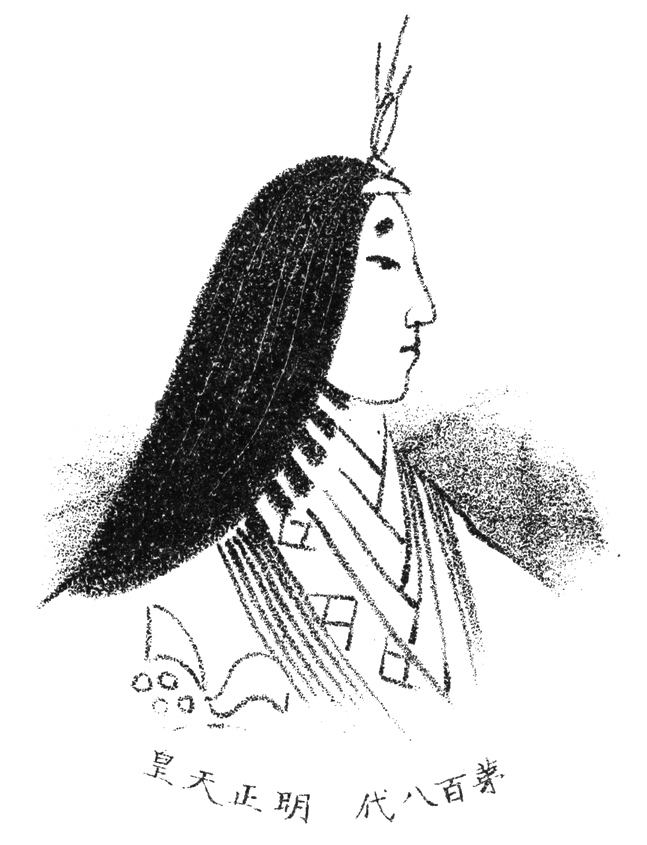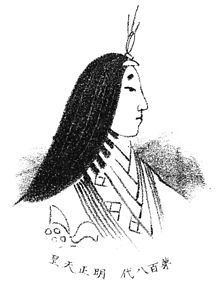Predecessor Go-Mizunoo Name Empress Meisho Parents Emperor Go-Mizunoo | Successor Komyo Role Ruler Grandparents Emperor Go-Yozei | |
 | ||
Reign December 22, 1629 – November 14, 1643 Similar People | ||
Empress Meishō (明正天皇, Meishō-tennō, January 9, 1624 – December 4, 1696) was the 109th Imperial ruler of Japan, according to the traditional order of succession. Her reign lasted from 1629 to 1643.
Contents

In the history of Japan, Meishō was the seventh of eight women to become empress regnant. The six who reigned before her were (a) Suiko, (b) Kōgyoku/Saimei, (c) Jitō, (d) Genmei, (e) Genshō, and (f) Kōken/Shōtoku. Her sole female successor was Go-Sakuramachi.
Genealogy
Before Meishō's accession to the Chrysanthemum Throne, her personal name (her imina) was Oki-ko (興子); and her pre-accession title was Onna-Ichi-no-miya (女一宮). She was the second daughter of Emperor Go-Mizunoo. Her mother was Tokugawa Masako, daughter of the second Tokugawa shōgun, Tokugawa Hidetada and his wife Oeyo. Hidetada was the son of Tokugawa Ieyasu and his consort, Oai.
Meishō lived within the Inner Apartments of the Heian Palace, as opposed to the section reserved for the women of the Imperial Court. She had no children of her own. Her name was derived by combining the names of two previous empresses, Empress Genmei (707–715) and her daughter Empress Genshō (715–724).
Events of Meishō's life
Okiko-naishinnō became empress following the abdication of her father. The succession (senso) was considered to have been received by the new monarch; and shortly thereafter, Empress Meishō is said to have acceded (sokui). The events during her lifetime shed some light on her reign. The years of Meishō's reign correspond with the development and growth of the Tokugawa shogunate under the leadership of Tokugawa Iemitsu.
Empress Meishō reigned for fifteen years. Although there were seven other reigning empresses, their successors were most often selected from amongst the males of the paternal Imperial bloodline, which is why some conservative scholars argue that the women's reigns were temporary and that male-only succession tradition must be maintained in the 21st century. Empress Gemmei, who was followed on the throne by her daughter, Empress Gensho, remains the sole exception to this conventional argument.
The kami of this empress is venerated in the imperial mausoleum at Tsuki no wa no misasagi, which is located at Sennyū-ji in Higashiyama-ku, Kyoto. Also enshrined is her father, Emperor Go-Mizunoo and her immediate Imperial successors – Go-Kōmyō, Go-Sai, Reigen, Higashiyama, Nakamikado, Sakuramachi, Momozono, Go-Sakuramachi and Go-Momozono.
Kugyō
Kugyō (公卿) is a collective term for the very few most powerful men attached to the court of the Emperor of Japan in pre-Meiji eras. Even during those years in which the court's actual influence outside the palace walls was minimal, the hierarchic organization persisted.
In general, this elite group included only three to four men at a time. These were hereditary courtiers whose experience and background would have brought them to the pinnacle of a life's career. During Meishō's reign, this apex of the Daijō-kan included:
Era of Meishō's reign
The years of Meishō's reign are encompassed within one era name or nengō.
